In October 2020 US mountain climber Chris Bombardier joined a panel of Australian rock climbers with haemophilia and HTC health professionals in a live chat with the Australian bleeding disorders community about taking on extreme adventure sport with severe haemophilia.
HFA Zoom and Facebook Live webinar for Bleeding Disorders Awareness Week, 16 October 2020
Watch the video of the live chat
Facilitator: Natashia Coco, Haemophilia Foundation Australia
Speakers:
Chris Bombardier, a mountain climber with severe haemophilia
Andrew and Scott Godwin, Australian brothers, rock climbers with severe haemophilia
Penny McCarthy, Clinical Nurse Consultant, Ron Sawers Haemophilia Centre, The Alfred, Melbourne
Alison Morris, Senior Musculoskeletal Physiotherapist, Perth Children’s Hospital
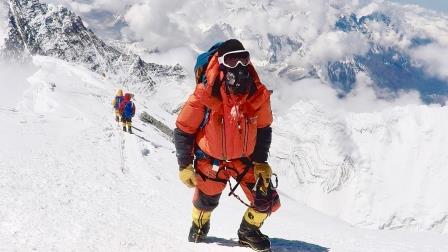
Chris taking the final steps to the summit of Mount Everest
Photo: Chris Bombardier
Climbing Mount Everest is an exceptional achievement for anyone, but for Chris Bombardier it also involved overcoming the challenges of having severe haemophilia B. In 2017 Chris partnered with film-maker Patrick James Lynch, who also has haemophilia, to document his journey through Nepal to the top of Mount Everest in a film titled Bombardier Blood. This journey was the culmination of a lifetime of struggle to deal with his haemophilia and to achieve his goal of climbing the Seven Summits, the highest mountains of each of the seven continents.
Along the way he was confronted by the limited access to haemophilia diagnosis and treatment in resource-poor countries like Nepal and the extraordinary efforts made by people with haemophilia and their families to manage their condition and their resulting disability and pain. The contrast with his haemophilia experience affected Chris profoundly. He is now the Executive Director of the Save One Life foundation, which provides direct financial assistance and medical treatment to people with bleeding disorders in developing countries, particularly children and youth.
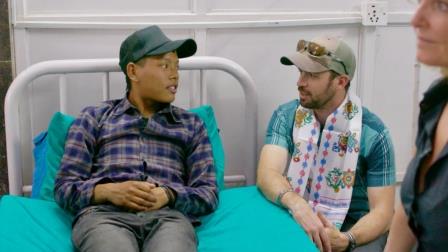
Chris at the hospital in Nepal with a community member with haemophilia
Photo: Chris Bombardier
Chris explained that he was a very active child and had played baseball throughout his young life. After college he was searching for something active to do and started mountain climbing with his uncle in Colorado. This involved considerable self-awareness: the safety of all climbers in the team depended on Chris being able to manage himself and his haemophilia, be prepared and to be clear to others beforehand when a situation would be too much for him.
There were also tricky aspects specifically related to treatment: how to carry his factor and keep it at the right temperature during the long trek to the mountain summit, how to infuse in the intense cold and teaching his walking companions about how to infuse him in an emergency.
Chris undertook the Everest summit while the international bleeding disorders community watched from afar. He made a point of taking a small flag signed by the local Nepalese haemophilia community to the top so that they could be with him in spirit and was very appreciative of the international support – with messages from as far afield as Tasmania.
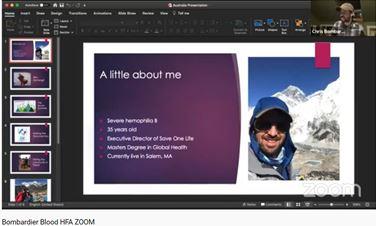
Reflecting on why he decided to start mountain climbing, Chris offered some very honest reflections about growing up with the challenges of haemophilia. When he was young, he had on demand therapy for bleeds as they occurred rather than prophylaxis treatment to prevent bleeds. He described the difficulties at school: the teasing about being on crutches, worrying about injuries at the playground and having to go to the emergency room, and feeling so different for such a long period of his life.
‘It wasn’t until after college when I got to meet with the haemophilia community that I realised that I had a story going on in my head all the time that I wasn’t good enough. I thought I was the only one facing those struggles. For me, meeting the bleeding disorders community and having that connection was a very powerful experience – to accept my bleeding disorder. To realise, yes, I have this thing that is different and a challenge for me, but there are other people who are going through it too, who can support me and who understand – who don’t think I am defective or wrong. I think this gave me the confidence to try these climbs and become an advocate for my community.’
Chris explained that he would have loved to be involved with haemophilia community camps earlier in his life.
‘I didn’t really know anyone with haemophilia growing up until after college. It would have been great to have been able to talk to people who understood what bleeds were like and the frustration you feel sometimes when you want be physically active and do something but your body is just not keeping up. I didn’t have anyone to talk to about that and it was really hard. I felt very lonely. I struggled with depression for a long time.
‘I had a lot of negative perceptions of haemophilia and I didn’t really accept my bleeding disorder before I got connected with other people. I hated having haemophilia, I really resented having it. I didn’t talk about it with other people, I didn’t share, because I didn’t want them to judge me and think differently of me. Even with my baseball team at high school and college: I would tell them I had haemophilia, but really downplay it and say, it’s no big deal, I just have to do this thing every once in a while.
‘Now that I am connected with the community, I have realised it is something I shouldn’t be ashamed of. Having it is not within my control – I was just born with it – but it has helped me to realise how to overcome challenges and be more resilient. People with bleeding disorders are pretty resilient people – pretty stubborn too! It has taught me empathy and compassion for other people and that is something I am proud of now.’
For Chris, understanding the value of working with his HTC on his treatment plan has come to him later in life, after he came to terms with having haemophilia.
‘When I was younger there were times when I didn’t listen to my HTC about taking my prophylactic treatment and that always ended up in not a good place. Even in college, when I was supposed to take my prophylaxis before baseball games, I didn’t want to do it. I didn’t want to have to stop and infuse and feel different. And so I didn’t do it, many times, and I ended up with some of the worst bleeds I have ever had because I didn’t follow their guidance. Now we work together on my physical activities and they help me figure it out.’
Sharing what he has learned from his climbing experience has been a way for Chris to connect to the worldwide bleeding disorders community and hopefully help others to meet their personal challenges.
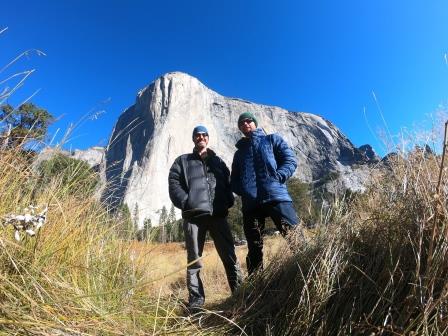
Andrew and Scott’s victory photo after climbing El Cap
Photo: Andrew and Scott Godwin
Two Australian brothers have also shared their climbing challenge experience to raise awareness about haemophilia and promote the message that ‘haemophilia doesn’t have to be a barrier to achieving something hard’ and that you might be capable of more than you think.
Scott and Andrew Godwin have severe haemophilia A and started rock climbing about 10 years ago. Scott had a dream of climbing El Capitan – an iconic vertical climb in Yosemite National Park – and persuaded his brother to take this on. They undertook about 6 months of training and achieved the difficult climb in 2019. They had a couple of attempts – they had to abandon the first attempt when Scott had a bleed – and completed the climb on their second attempt.
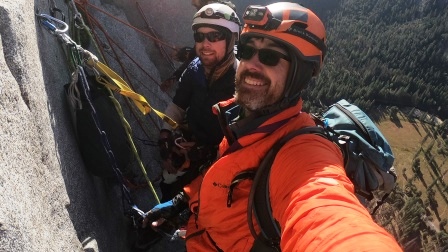
Andrew and Scott climbing El Capitan
Photo: Andrew and Scott Godwin
The panel took the opportunity of the chat with the audience after the presentations to discuss some of the questions and issues that had come up for them.
How to motivate young people to exercise?
Who was involved in training for Chris’s climb?
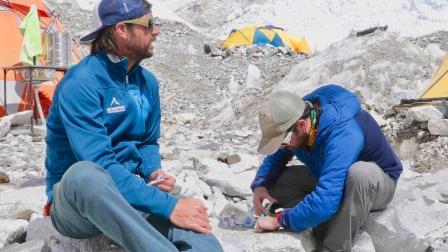
Chris infusing his factor at Mount Everest Base Camp with guide Ryan Waters
Photo: Chris Bombardier
‘The Treatment Centre staff were amazing,’ said Chris. ‘I don’t know that they were super-excited by my idea, but they knew I was going to do it anyway, so they would rather be part of that discussion rather than try to fight it.’
Ali and Penny underlined that HTCs wanted their patients to be active and the aim would be to work out a treatment plan to protect you as much as possible.
How do you manage mountain climbing with joint problems?
A comment from a parent attending the Live Chat summed it up:
‘A massive thank you for showing that you can do anything if you have haemophilia with the right treatment. Two boys with severe haemophilia A here, one who struggled with inhibitors for years, and we live by the motto of not letting their haemophilia define them, provided their treatment is done.’
Our thanks to Chris, Andrew and Scott for sharing their stories so generously, and to Ali and Penny for their support.
If you would like more information about sport and exercise for you or your child, speak to your Haemophilia Treatment Centre. Contact details of HTCs are on the HFA website.
You can also find more information about sport and exercise, along with personal stories, on the HFA Factored In youth website.
You can buy and watch the Bombardier Blood movie here
Read and watch Andrew and Scott’s story of training for and climbing El Capitan
Haemophilia Foundation Australia acknowledges the Traditional Owners and Custodians of Country throughout Australia, the land, waters and community where we walk, live, meet and work. We pay our respects to Elders past and present and extend that respect to all Aboriginal and Torres Strait Islander peoples.
Sign up for the latest news, events and our free National Haemophilia magazine